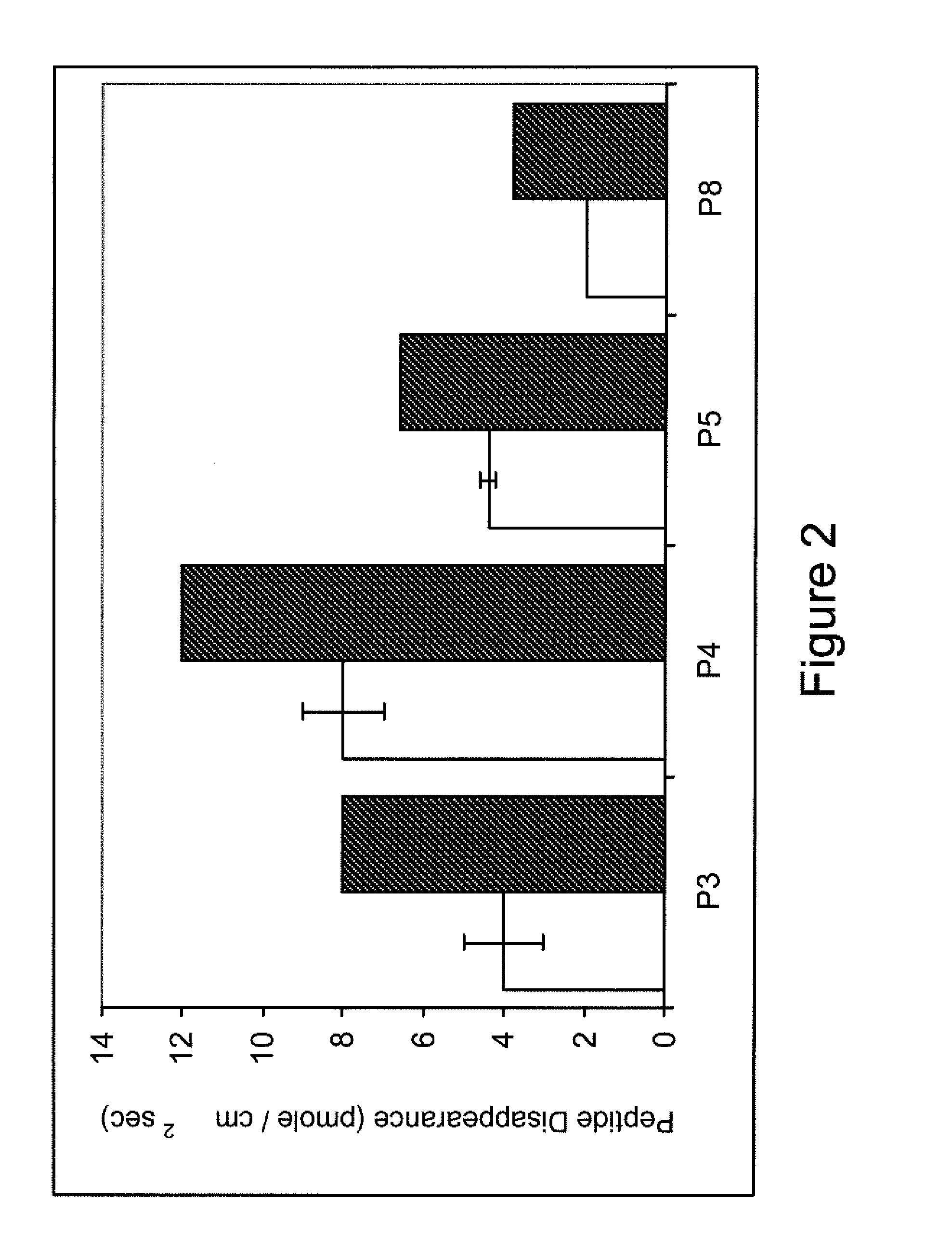Glutenase enzyme assays
a technology of glucose and enzymes, applied in the field of glucose enzyme assays, can solve the problems of no good treatment for eczema, few patients respond poorly or not at all, and the diagnosis is erroneous, so as to prevent or relieve the toxic effects of gluten oligopeptides, the effect of decreasing the level of toxic gluten oligopeptides
- Summary
- Abstract
- Description
- Claims
- Application Information
AI Technical Summary
Benefits of technology
Problems solved by technology
Method used
Image
Examples
example 1
[0082]By comparing the in vitro and in vivo digestion of a panel of structurally diverse γ- and β-gliadin derived peptides that are believed to induce toxic effects in Celiac Sprue, we were able to quantify their relative resistance to digestion. The experimentally measured parameters were used to develop a quantitative model for the luminal content of gliadin peptides in the human intestine. Our findings indicate that toxic gliadin peptides persist ˜4-8 times longer in the intestine than physiologically relevant controls from low-proline fractions of gliadin or from myoglobin. Quantitative analysis of in vivo prolyl endopeptidase (PEP) supplementation demonstrated that resistant gliadin peptides could be effectively proteolyzed at rates comparable to non-immunogenic control peptides.
Methods
Materials
[0083]A summary of the peptides used in the following experiments, the source, and peptide identifiers can be found in Table 1. Throughout this report peptides are identified by their se...
example 2
Peptidase Supplementation as Therapy for Celiac Sprue—Demonstration of Efficacy and Safety in Rats and Humans In Vivo
[0107]Once the ideal ratio of PEP to gliadin peptide is determined in these perfusion experiments, one can analyze the capacity of the PEP to enhance the hydrolysis of gluten peptides in commercial gluten-containing wheat flour. A 1% slurry of the flour mixed with 1:100 (weight basis) trypsin and chymotrypsin, and 1:500 (weight basis) elastase is perfused into the intestine with or without co-perfusion of suitable. quantities of the PEP. LC-MS analysis of the residual gliadin products is conducted on the collected samples, and the histologic and enzymatic parameters are examined, as described above.
[0108]Feeding studies in intact rats can be conducted as follows. Once the ideal ratio of the PEP to the gliadin substrate has been established in the perfusion experiments, rats are fed 70% carbohydrate chow containing wheat flour, which is used as the conventional rat cho...
example 3
Heterologous Expression of PEP in Lactobacilli
[0116]In one embodiment of the present invention, a Celiac Sprue patient is provided with a recombinant organism modified to express a PEP of the invention. The recombinant organism is selected from those organisms that can colonize the intestinal mucosa without detriment to the patient, thereby providing an endogenous source of PEP to the patient. As one example, Lactobacilli such as L. casei and L. plantarium can colonize the intestinal mucosa and secrete PEP enzymes locally. Given their widespread use in food processing, they can also be used as an efficient source of PEP for industrial (to treat foodstuffs) and medical (to prepare PEP for pharmaceutical formulation) use. PEPs can be expressed in such lactobacilli using standard recombinant DNA technologies. For example, Shaw et al. (Shaw, D M, Gaerthe, B; Leer, R J, Van der Stap, J G M M, Smittenaar, C.; Den Bak-Glashouwer, Heijne, M J, Thole, J E R, Tielen F J, Pouwels, P H, Haveni...
PUM
| Property | Measurement | Unit |
|---|---|---|
| pH | aaaaa | aaaaa |
| pH | aaaaa | aaaaa |
| concentration | aaaaa | aaaaa |
Abstract
Description
Claims
Application Information
 Login to View More
Login to View More - R&D
- Intellectual Property
- Life Sciences
- Materials
- Tech Scout
- Unparalleled Data Quality
- Higher Quality Content
- 60% Fewer Hallucinations
Browse by: Latest US Patents, China's latest patents, Technical Efficacy Thesaurus, Application Domain, Technology Topic, Popular Technical Reports.
© 2025 PatSnap. All rights reserved.Legal|Privacy policy|Modern Slavery Act Transparency Statement|Sitemap|About US| Contact US: help@patsnap.com



